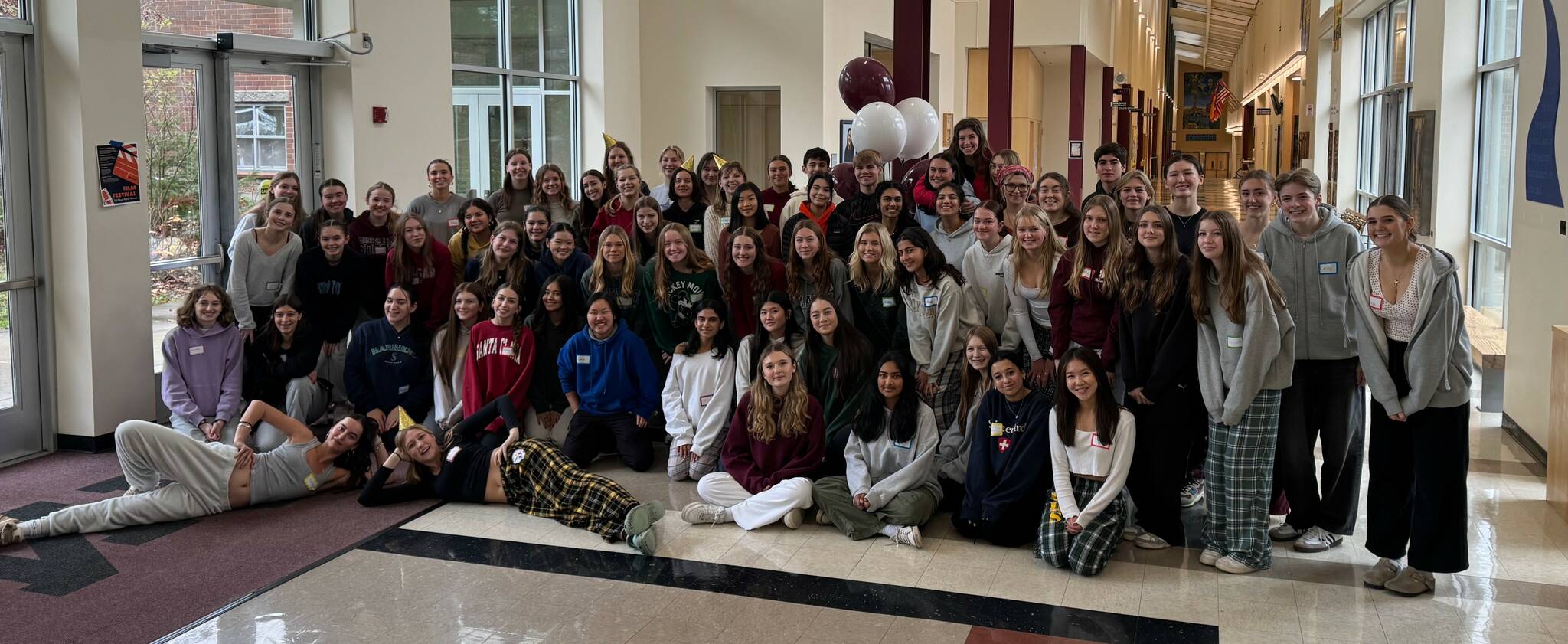
Students strive to build meaningful connections with Kenyan pen pals throughout the year.
By Soyun Chow
Special to the Reporter
Delinah Wughanga hopes to be a lawyer and help prevent child abuse. Holiness Mwake wants to be a neurosurgeon and open a clinic to help people in her community. Other scholars aspire to become engineers, teachers, and provide cleaner water for their community. Those are just some of the goals of students in Taita-Taveta county in rural Kenya who recently received scholarships from the SeaVuria Scholarship Program to attend high school this year.
Scholarships are crucial for some scholars, especially girls, to continue their education since many families cannot afford the yearly school fees to attend high school in Taita-Taveta. It costs approximately $300 a year for a day scholar and $600 for a boarding school scholar in Taita-Taveta to attend high school.
On Dec. 8, 66 students from Mercer Island High School (MIHS) and Vashon Island High School (VHS) joined together for an all-day meeting at MIHS to carefully review more than 200 scholarship applications and selected 125 Kenyan students from 10 schools to receive scholarships for the upcoming school year, which started in January in Taita-Taveta. They also discussed safety net services to ensure their success.
The $46,000 in scholarship funds were made possible by the fundraising of MIHS PETRI (Philanthropy, Education, Teaching, Research, Involvement) club and VHS G2G (Girls to Girls) club. Both clubs seek to empower young women in Kenya and the U.S. through education, scholarships and friendship. SeaVuria is the fiscal sponsor of PETRI and G2G clubs.
MaryMargaret Welch, PETRI and G2G adviser and co-founder/executive director of SeaVuria, said, “It’s really a privilege to be able to work with youth who see themselves as global citizens, putting those who are less fortunate as priorities in their lives. I’m proud of our local youth, proud of the work they do every day, and really excited for this upcoming year to build these relationships. We’ve been working hard to move relationships between Kenya and the U.S. youth from the donor/recipient to the friendship relationship.”
In early January, scholarship recipients in Taita-Taveta received SeaVuria scholarship letters of acceptance, which included a note of congratulations stating that 90% of their school fees for the 2025 academic year would be covered.
It also stated that the primary focus of the scholarship is to foster meaningful relationships between girls in Kenya and Seattle, creating opportunities for mutual learning and friendship.
This friendship continues throughout the school year with the pen pal connections. Each PETRI and G2G student will have Kenyan pen pals with regular correspondences, including monthly Zoom calls and frequent Google chats and emails.
The first Zoom call was on Jan. 22 and MIHS junior Savanna Rousell, PETRI scholarship correspondence vice president, said: “Creating impactful friendships has always been an important goal of ours. Through these, not only do we get to learn about a different education system and culture, but we also see the many similarities between us. It also gives both sides a lot of female role models to look up to, which is especially important in Kenya where it’s harder for women to see themselves in these roles.”
Though most of the scholarship recipients are girls, an all-boys school, St. Mary’s, was included for scholarships six years ago and there are currently 14 boys who have received scholarships this year.
Welch said the decision to include boys for scholarships “boiled down to the decision that if boys in a patriarchal society can see the power and good will of women, it would influence the way they approach gender issues in their daily lives. I think that has shown itself to be true.”
MIHS senior Josie Beebe, PETRI president, said one of the St. Mary’s scholarship recipients stated in his application that “he wants to help people the way we do. He wants to help fund other kids’ secondary education in Kenya so they could get through high school and hopefully have more opportunities in their career field in the future. That was really inspiring.”
There were many other inspiring stories that Beebe and other students read during the scholarship application review. MIHS and VHS students looked at applicants’ grades and read through personal statements, which included goals of what they want to do with their education. Applications also included letters of support from their principals, which could include scholars’ personal challenges. Some of the tough issues faced included a student who goes to bed hungry every night and a scholar who is currently pregnant but wants to continue her education.
Tekla Machaki, a student at Mwakitau Secondary School, had to walk a long distance to and from school and was “afraid of meeting elephants during that walk.” After receiving the scholarship that pays for her boarding fees, she has more time to study, participate in school activities, and is now a leader in her school. She wants to pursue a career in nursing after she graduates.
By reading through the applications, VHS senior Eva Nelson, G2G social media manager vice president, learned that there is a lack of hospitals in Kenya and access to healthcare. Some of the applicants want to go into the medical field to solve those issues and make hospitals more accessible.
“They were very thoughtful in their decision making about what they want to do with their future,” she said.
MIHS junior Mahi Agarwal, PETRI scholarship correspondence vice president, agreed and added that “a lot of the girls had a lot of very specific goals, especially to give back to the community,” including a student who wanted to provide cleaner water for her community.
The inspiration for this student’s goal to provide clean water was influenced by a science fair project last February. During their visit to Kenya, PETRI and G2G spent time listening to the problems that their pen pals had identified in their own community that they could use science to solve. Access to clean water was one of the projects since residents in Taita-Taveta must collect water every day. Students discussed methodologies to clean the water so waterborne pathogens wouldn’t be an issue in their community.
The PETRI club meets once a month at MIHS and has fundraisers throughout the year, including selling handwoven baskets made by Kenyan scholars’ parents and organizing the fall fundraiser in November, where they give presentations and raise most of their funds. Upcoming fundraisers this year include selling Pura Vida bracelets for Valentine’s Day, raising awareness and funds for Period Poverty in March during National Women’s History Month, and having a STEM Summer Camp for elementary students. Welch is a former MIHS science teacher and previous director of pre-K-12 science programs for Seattle Public Schools.
Every other year, several PETRI and G2G club members take a trip to Kenya to visit scholarship recipients and pen pals to deepen friendships that will last a lifetime.
PETRI club is happy to welcome new members anytime during the school year and MIHS students can contact seavuria@gmail.com if they would like to join.
MIHS sophomore Kira Lackland, PETRI vice president of media, joined the club last year as a freshman and said it has been a meaningful and fun experience.
“When I was a new member, I felt really welcomed from the start,” she said. “Everyone in the club is super nice and inviting.”
She has continued to build friendships with other club members and connect during meetings and fundraisers.
PETRI club was founded in 2014 when MIHS students partnered with students in Kenya on a collaborative science project and discovered that some of the Kenyan students could not stay in school because they could not pay for school fees. MIHS students knew they could do something about that and decided to have a fundraiser to help pay for scholars to attend high school, and this eventually led to forming the PETRI club, with sister club G2G from Vashon Island later joining the group.
The mission continues in college with the WEE (Women’s Empowerment through Education) club, where former PETRI and G2G students, who themselves are now in college, fundraise to provide university scholarships and build global friendships with young women in Kenya.
Zawadi Hamadi, who is earning her bachelor’s in chemical engineering at Moi University, wrote that the WEE Scholarship “has been truly life-changing” and provided her an opportunity to continue her education and have a meaningful friendship with her pen pal. “This experience has been inspiring and deeply enriching, and I’m so grateful for it.”
As part of the scholarship program this year, SeaVuria is supporting students with wrap-around funds, which may include hiring another mentor in Kenya, setting an emergency fund, and purchasing more Chromebooks. Scholars currently share Chromebooks, which are used for homework and research and are a main communication source for them.
High school scholarship recipient Lilian Mwanyalo wrote that the Chromebooks have helped her learn how to use technology and communicate with her pen pal through Google chats and emails. In addition to the technology support, she is grateful for how the scholarship has “helped my family to lessen the burden and educate my other siblings, which makes me happy.”
Stellah Kidongi, a former SeaVuria scholarship recipient, is now a SeaVuria program coordinator and mentor. She coordinates correspondence and provides mentorship for scholars from the 10 schools.
Kidongi stated the importance of the SeaVuria mentorship program: “The girls in my community are intelligent and ambitious, but they face significant challenges that hinder their progress, including limited access to role models, sexual and reproductive health concerns, mental health struggles, and persistent gender stereotypes, such as the belief that STEM is not for girls. The mentorship program was created to empower them, helping them envision and pursue their dreams while equipping them with the tools to overcome these barriers. Through mentorship and support, I have witnessed firsthand how they gain the confidence to seek help and take charge of their futures.”
To learn more about SeaVuria, go to www.seavuria.org or on Instagram @seavuria.petri.
Scholars gather for the Bura Girls School assembly. Bura is the largest of 10 schools to receive SeaVuria scholarships. Photo courtesy of MaryMargaret Welch
Mercer Island High School junior Savanna Rousell, PETRI vice president of scholarship correspondence, holds a letter of acceptance that went to a SeaVuria scholarship recipient. Photo courtesy of Savanna Rousell
Mercer Island High School PETRI and Vashon Island High School G2G gather to review scholarship applications and select scholarship recipients. Photo courtesy of MaryMargaret Welch
Sign Up
**Update: The city reports that all previously closed roads have been reopened.
Mercer Island School District (MISD) Superintendent Fred Rundle connected with families, students and the community in a letter on Feb….
Students strive to build meaningful connections with Kenyan pen pals throughout the year.


Recent Comments